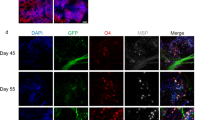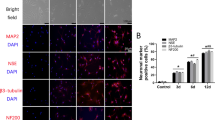Abstract
Oligodendrocyte progenitor cells (OPCs) transplantation has been considered a promising treatment for spinal cord injury, according to previous studies. Recent research shed light on the importance of microRNA 219 (miR-219) in oligodendrocyte development, so here miR-219-overexpressing OPCs (miR-219 OPCs) were transplanted in animal models of spinal cord injury to evaluate the impact of miR-219 on oligodendrocyte differentiation and functional recovery in vivo. Our findings demonstrate that transplanted cells were distributed in the tissue sections and contributed to reducing the size of cavity in the injury site. Interestingly, miR-219 promoted OPC differentiation into mature oligodendrocyte expressing MBP in vivo whereas in absence of miR-219, less number of cells differentiated into mature oligodendrocytes. An eight week evaluation using the Basso Beattie Bresnahan (BBB) locomotor test confirmed improvement in functional recovery of hind limbs. Overall, this study demonstrated that miR-219 promoted differentiation and maturation of OPCs after transplantation and can be used in cell therapy of spinal cord injury.






Similar content being viewed by others
Data availability
All data generated or analyzed during this study are included in this published article.
References
Assinck P, Duncan GJ, Hilton BJ, Plemel JR, Tetzlaff W (2017) Cell transplantation therapy for spinal cord injury. Nat Neurosci 20(5):637
Bartus K, Burnside E, Galino J, James N, Bennett D, Bradbury E (2019) ErbB receptor signaling directly controls oligodendrocyte progenitor cell transformation and spontaneous remyelination after spinal cord injury. Glia 67:1036–1046
Basso DM (2004) Behavioral testing after spinal cord injury: congruities, complexities, and controversies. J Neurotrauma 21:395–404
Basso DM. Beattie MS, Bresnahan JC (1995) A sensitive and reliable locomotor rating scale for open field testing in rats. J Neurotrauma 12:1–21
Chen LX, Ma SM, Zhang P, Fan ZC, Xiong M, Cheng GQ,. . Li J (2015) Neuroprotective Effects of Oligodendrocyte Progenitor Cell Transplantation in Premature Rat Brain following Hypoxic-Ischemic Injury. PLoS One 10(3):e0115997
Dugas JC, Cuellar TL, Scholze A, Ason B, Ibrahim A, Emery B,. . Barres BA (2010) Dicer1 and miR-219 are required for normal oligodendrocyte differentiation and myelination. Neuron 65(5):597–611
Fan H-B, Chen L-X, Qu X-B, Ren C-L, Wu X-X, Dong F-X, Yao R-Q (2017) Transplanted miR-219-overexpressing oligodendrocyte precursor cells promoted remyelination and improved functional recovery in a chronic demyelinated model. Sci Rep 7:41407
Führmann T, Tam R, Ballarin B, Coles B, Donaghue IE, Van Der Kooy D, Shoichet MS (2016) Injectable hydrogel promotes early survival of induced pluripotent stem cell-derived oligodendrocytes and attenuates longterm teratoma formation in a spinal cord injury model. Biomaterials 83:23–36
Holtz A, Nyström B, Gerdin B (1989) Blocking weight-induced spinal cord injury in rats: effects of TRH or naloxone on motor function recovery and spinal cord blood flow. Acta Neurol Scand 80:215‐220
Hudish L, Galati D, Ravanelli A, Pearson C, Huang P, Appel B (2016) miR-219 regulates neural progenitors by dampening apical Parprotein-dependent Hedgehog signaling. Development 143:2292–2304
Kachadroka S, Hall AM, Niedzielko TL, Chongthammakun S, Floyd CL (2010) Effect of endogenous androgens on 17β-estradiol-mediated protection after spinal cord injury in male rats. J Neurotrauma 27:611–626
Kawabata S, Takano M, Numasawa-Kuroiwa Y, Itakura G, Kobayashi Y, Nishiyama Y, Okano H (2016) Grafted human iPS cell-derived oligodendrocyte precursor cells contribute to robust remyelination of demyelinated axons after spinal cord injury. Stem Cell Rep 6(1):1–8
Kloos AD, Fisher LC, Detloff MR, Hassenzahl DL, Basso DM (2005) Stepwise motor and all-or-none sensory recovery is associated with nonlinear sparing after incremental spinal cord injury in rats. Exp Neurol 191:251–265
Li F, Zhou MW, Liu N, Yang YY, Xing HY, Lu Y, Liu XX (2019) MicroRNA-219 inhibits proliferation and induces differentiation of oligodendrocyte precursor cells after contusion spinal cord injury in rats. Neural Plast 2019:9610687
Lü H-Z, Wang Y-X, Zhou J-S, Wang F-C, Hu J-G (2010) Cyclosporin A increases recovery after spinal cord injury but does not improve myelination by oligodendrocyte progenitor cell transplantation. BMC Neurosci 11(1):127
Manley NC, Priest CA, Denham J, Wirth ED, Lebkowski JS (2017) Human embryonic stem cell-derived oligodendrocyte progenitor cells: preclinical efficacy and safety in cervical spinal cord injury. Stem Cells Transl Med 6(10):1917–1929
Murai K, Sun G, Ye P, Tian E, Yang S, Cui Q,. . Shi Y (2016) The TLX-miR-219 cascade regulates neural stem cell proliferation in neurodevelopment and schizophrenia iPSC models. Nat Commun 7:10965
Nagoshi N, Khazaei M, Ahlfors JE, Ahuja CS, Nori S, Wang J, Fehlings MG (2018) Human Spinal oligodendrogenic neural progenitor cells promote functional recovery after spinal cord injury by axonal remyelination and tissue sparing. Stem Cells Transl Med 7(11):806–818
Namjoo Z, Moradi F, Aryanpour R, Piryaei A, Joghataei MT, Abbasi Y, Beyer C (2018a) Combined effects of rat Schwann cells and 17β-estradiol in a spinal cord injury model. Metab Brain Dis 33(4):1229–1242
Namjoo Z, Mortezaee K, Joghataei MT, Moradi F, Piryaei A, Abbasi Y, Majidpoor J (2018b) Targeting axonal degeneration and demyelination using combination administration of 17β-estradiol and Schwann cells in the rat model of spinal cord injury. J Cell Biochem 119(12):10195–10203
Nazari B, Soleimani M, Ebrahimi-Barough S, Enderami SE, Kazemi M, Negahdari B, Ai J (2018a) Overexpression of miR-219 promotes differentiation of human induced pluripotent stem cells into pre-oligodendrocyte. J Chem Neuroanat 91:8–16
Nazari B, Soleimanifar F, Kazemi M, Nazari B, Enderami SE, Ai A, Ai J (2018b) Derivation of preoligodendrocytes from human-induced pluripotent stem cells through overexpression of microRNA 338. J Cell Biochem 120(6):9700–9708
Nazari B, Kazemi M, Kamyab A, Nazari B, Ebrahimi-Barough S, Hadjighassem M, Ai J (2019) Fibrin hydrogel as a scaffold for differentiation of induced pluripotent stem cells into oligodendrocytes. J Biomed Mater Res B Appl Biomater 108(1):192–200
Nori S, Okada Y, Yasuda A, Tsuji O, Takahashi Y, Kobayashi Y,. . Ikeda E (2011) Grafted human-induced pluripotent stem-cell–derived neurospheres promote motor functional recovery after spinal cord injury in mice. Proc Natl Acad Sci 108(40):16825–16830
Shahrezaie M, Mansour RN, Nazari B, Hassannia H, Hosseini F, Mahboudi H,. . Vasmehjani AA (2017) Improved stem cell therapy of spinal cord injury using GDNF-overexpressed bone marrow stem cells in a rat model. Biologicals 50:73–80
Sharp J, Frame J, Siegenthaler M, Nistor G, Keirstead HS (2010) Human embryonic stem cell-derived oligodendrocyte progenitor cell transplants improve recovery after cervical spinal cord injury. Stem Cells 28(1):152–163
Wang H, Moyano AL, Ma Z, Deng Y, Lin Y, Zhao C (2017) miR-219 cooperates with miR‐338 in myelination and promotes myelin repair in the CNS. Dev Cell 40:566‐582
Zhao X, He X, Han X, Yu Y, Ye F, Chen Y,. . Lu QR (2010) microRNA-mediated control of oligodendrocyte differentiation. Neuron 65:612‐626
Funding
This study was funded by Tehran University of Medical Sciences (grant number 93-04-87-27710).
Author information
Authors and Affiliations
Contributions
Jafar Ai, Esmaeil Sadroddiny, and Bahareh Nazari designed the study. Bahareh Nazari, Zeinab Namjoo, and Fateme Moradi performed the practical parts of the study. Bahareh Nazari, Mansure Kazemi, and Somayeh Ebrahimi-Barough contribute to writing the manuscript. Esmaeil Sadroddiny, and Jafar Ai supervised the study. All authors read and approved the final manuscript.
Corresponding authors
Ethics declarations
Conflict of interest
There is no conflict of interest.
Ethical approval
All applicable international, national, and/or institutional guidelines for the care and use of animals were followed.
Additional information
Publisher’s note
Springer Nature remains neutral with regard to jurisdictional claims in published maps and institutional affiliations.
Rights and permissions
About this article
Cite this article
Nazari, B., Namjoo, Z., Moradi, F. et al. miR-219 overexpressing oligodendrocyte progenitor cells for treating compression spinal cord injury. Metab Brain Dis 36, 1069–1077 (2021). https://doi.org/10.1007/s11011-021-00701-y
Received:
Accepted:
Published:
Issue Date:
DOI: https://doi.org/10.1007/s11011-021-00701-y




